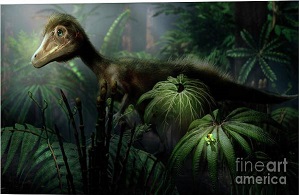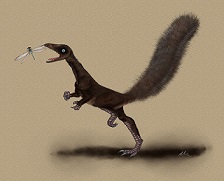
Sciurumimus, Dinosaur a name that means squirrel mimic is a genus of theropod dinosaur that roamed the Earth during the Late Jurassic period, approximately 150 million years ago. What sets Sciurumimus apart from many other dinosaurs is its well-preserved fossils, which have offered significant insights into the early evolution of feathers in dinosaurs. In this exploration, we will delve into the classification, physical characteristics, habitat, behavior, and significance of Sciurumimus in the world of paleontology.
Sciurumimus belongs to the theropod group, a diverse family of bipedal carnivorous dinosaurs that includes well-known giants like Tyrannosaurus rex and Velociraptor. It is classified within the Coelurosauria group, which is characterized by their relatively slender build and, in many cases, feathers.
The first fossils of Sciurumimus were discovered in the Solnhofen Limestone Formation in Bavaria, Germany, famous for its remarkable fossil preservation. These fossils include both juvenile and adult specimens, providing unique insights into the life stages of these ancient creatures.
| Name: | Sciurumimus dinosaurs |
| Size: | Around 70 centimeters (27.5 inches) in length, 2 to 3 kilograms (4.4 to 6.6 pounds) in weight. |
| Main Facts: | Sciurumimus is known for its feathered fossil, offering insights into early feather evolution and its significance in the dinosaur-bird transition. |
Sciurumimus lived during the Late Jurassic period, a time when dinosaurs were flourishing. Fossils of Sciurumimus have been found in what is now modern-day Germany, suggesting a habitat that included both terrestrial and possibly semi-aquatic environments.
As a small theropod, Sciurumimus likely preyed on smaller animals, such as insects and small vertebrates. Its feathers, which were likely used for insulation and display, represent an early stage in the evolution of feathers, contributing to our understanding of how these structures developed in dinosaurs.

Sciurumimus possessed several distinctive physical characteristics :
One of the most significant aspects of Sciurumimus is the presence of feathers. While direct evidence of feathers was not preserved, the proximity of these fossils to feather impressions strongly suggests that Sciurumimus was feathered, representing one of the early feathered dinosaurs.
Sciurumimus had a relatively slender and lightweight body, characteristic of many coelurosaurs.
Like most theropods, it walked on two legs, with sharp claws on its feet for capturing prey.
Sciurumimus holds significant importance in the field of paleontology for several reasons :
Sciurumimus provides critical evidence of feathers in dinosaurs and offers insights into the early evolution of these structures. The presence of feathers suggests that they were not exclusive to avian dinosaurs but were present in various theropod lineages.
The discovery of both juvenile and adult specimens of Sciurumimus provides valuable data on how these dinosaurs grew and developed, offering a glimpse into their life stages.
As a coelurosaur, Sciurumimus contributes to our understanding of the evolution and diversification of theropod dinosaurs, a group that includes some of the most iconic dinosaurs in history.
Sciurumimus, a dinosaur from the Late Jurassic period, about 150 million years ago, was a small theropod known for its feathered appearance. Fossils of this carnivorous dinosaur were discovered in Germany. Sciurumimus measured approximately 2.5 feet in length and exhibited a body covered in feathers, suggesting that it was one of the early feathered dinosaurs.
It had a slender build, walked on two legs, and likely preyed on smaller animals. The discovery of Sciurumimus has contributed to our understanding of the evolution of feathers and the diversity of theropod dinosaurs during the Jurassic period.
Sciurumimus was a small theropod dinosaur, about 70 centimeters in length. Comparing its size to other theropods, such as the massive Tyrannosaurus rex or the agile Velociraptor, highlights the tremendous size range among theropods.
Sciurumimus is known for its remarkable feathered fossil, shedding light on the presence and structure of feathers in early theropods. This discovery has implications for understanding the evolution of feathers and the transition to avian flight.
Like many theropods, Sciurumimus was a carnivore, likely preying on small vertebrates and insects. Comparing its diet to herbivorous dinosaurs underscores the diverse feeding habits among dinosaurs.
Sciurumimus lived during the Late Jurassic period, sharing the era with other famous dinosaurs like Stegosaurus and Brachiosaurus, allowing us to understand the coexistence and interactions of various species.
Sciurumimus, like most theropods, was bipedal, emphasizing the commonality of this locomotion in theropod dinosaurs.
The feathered fossil of Sciurumimus contributes to our understanding of feather evolution in theropods and the possible role of feathers in thermoregulation or display.
Some scientists have suggested that Sciurumimus could represent a juvenile stage of another dinosaur species, underscoring the challenges of interpreting dinosaur fossils and their growth stages.